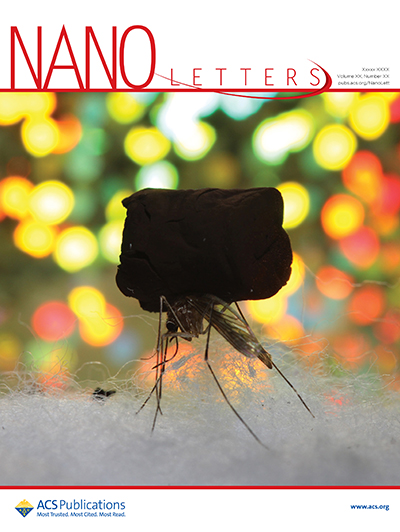New ultralight gold foam shimmers in the limelight
 (Download Image)
(Download Image)
Ultra-lightweight gold, copper and silver foams are lighter than a parakeet feather. Illustration by Amy Henke/LLNL
Lawrence Livermore National Laboratory (LLNL) scientists have created the lightest gold foam to date.
The new form of ultralight gold aerogel foam has applications in electronics, catalysis, sensors and energy conversion and storage. The research appears in the journal Nano Letters. It will be published in the November issue, and was selected for the supplementary journal cover.
The gold aerogels are so light that they could be carried on the back of fragile insects. Cover image photo by Joshua DeOtte/LLNLAerogels are a type of material that are lightweight, have a high surface area and are made up of a nanoporous network with densities between 1 and 1,000 milligrams per cubic centimeter. A wide range of metals and metal alloys have been made into ultralight, monolithic foams, including nickel, cobalt, copper and silver.
However, the synthesis of ultralight gold aerogel foams has remained elusive. Ultralow-density gold foams with microscopically uniform pores are uniquely suited as targets for ultrabright X-ray sources and studying high-energy-density physics at high-power laser facilities. This is a very impactful work, as it demonstrates the lightest gold foam in the world, and will be used for targets for the National Ignition Facility (the largest and most energetic laser in the world).
“These gold aerogels were so light that they could be carried on the back of fragile insects, or even blown away by gentle breath, which used to be a big technical challenge in the experiments,” said LLNL material scientist Fang Qian, lead author of the paper. “We have created new approaches to prepare high-quality gold nanowires in large quantities to ensure sufficient material supply for the foam fabrication, with densities tuned in a predictable manner. Density tunability is important because key physical properties of metal foams — such as stiffness, strength, electrical conductivity, thermal conductivity and X-ray opacity — scale with density.”
The team created the ultralight gold foam by starting with gold nanowires of uniform size with ultrathin diameters and high purity and high aspect ratios. The team members then freeze-cast the nanowires to produce free-standing aerogels with densities down to 6 milligrams per cubic centimeter.
Successful fabrication of metallic nanowire-based foams starts with the synthesis of high-quality nanowire feedstocks. “Our team has been working on synthesis of metallic nanowires for a number of years, with emphasis on producing high-quality nanowires at scale, necessary to produce high-quality metallic aerogels,” said LLNL materials scientist Yong Han, a co-author of the paper. “Developing robust processes to reproducibly synthesize high-quality metallic nanowires is a major challenge our team has been working on. We continue to innovate our processes to deliver high-quality materials to meet the demands of our Lab’s missions.”
“Producing millimeter-scale gold aerogels at this low density was quite unexpected and underscores the opportunities presented by freeze-casting metal nanowire solutions,” said LLNL materials scientist Michael Bagge-Hansen, the project’s principal investigator and a co-author of the paper. “I am enthused with the positive impact of this work — it really adds another capability to our toolbox."
In addition to making gold nanowires, the team has begun unraveling the complex science of freeze-drying to control the structure, uniformity and robustness of the resulting gold foams. To transition research from the lab to the field, the metal foams need to be robust.
“These gold foams are mechanically stable, compared to early samples that were similar in strength to a long cigarette ash,” said Brent Blue, the director of the National Security Program. “They can be squeezed or dropped, and they bounce back and hold their shape very well, which is a critical quality for use as a bright, X-ray source. This is an amazing feat given that even though they look solid, they are 99.9 percent void, or 0.1 percent solid.”
Other LLNL researchers include Alyssa Troksa, Tyler Fears, Michael Nielsen, Art Nelson, Theodore Baumann and Sergei Kucheyev. The research was funded through LLNL’s Laboratory Research and Development program.
Contact
 Anne M. Stark
Anne M. Stark
[email protected]
(925) 422-9799
Related Links
Nano LettersTags
Physical and Life SciencesFeatured Articles








